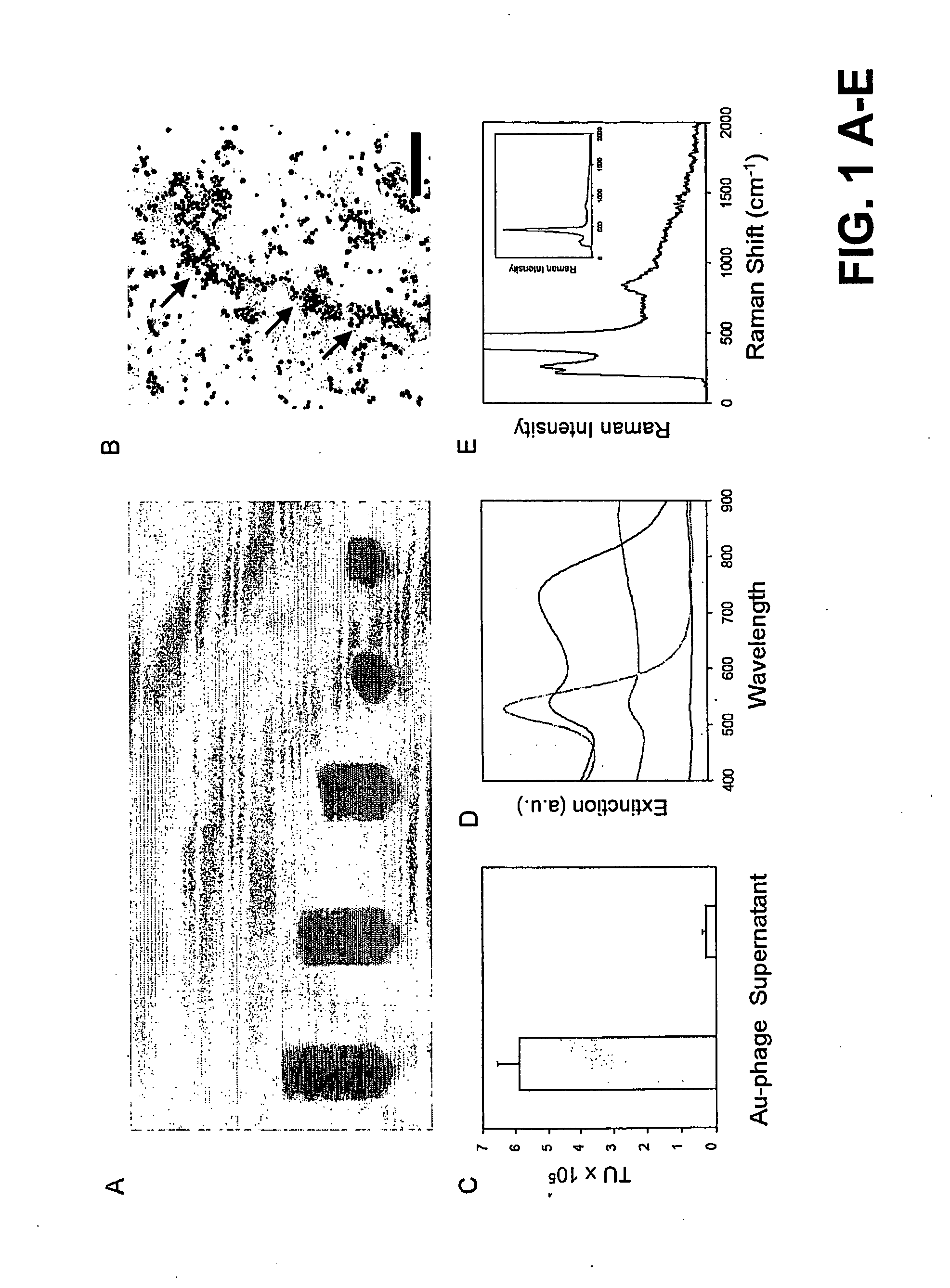Methods and compositions related to phage-nanoparticle assemblies
a technology of nanoparticles and phages, applied in the field of phage-nanoparticle assemblies, can solve the problem of not showing compelling evidence that nanoparticles do not assemble onto phages, and achieve the effect of increasing the ratio of conductive clusters to bacteriophages
- Summary
- Abstract
- Description
- Claims
- Application Information
AI Technical Summary
Benefits of technology
Problems solved by technology
Method used
Image
Examples
example 1
[0162]To study spontaneous assembly without modifying the phage capsid, the Inventors designed and validated an alternative approach for phage-based nano-assembly that does not rely on genetic manipulation or complex conjugation chemistry. The inventors show, for example, self-assembly direct-assembly of gold (Au) nanoparticles onto phage templates by simply manipulating solution properties (FIG. 1A-1E). Morphologically stable and distinct. networks (FIG. 1A) of self-assembled (FIG. 1B), biologically active (FIG. 1C) Au-phage assemblies were generated. Moreover, varying conditions altered the mechanical (FIG. 1A) and optical properties of the assemblies (FIG. 1D); this result not only supports the assembly of Au nanoparticles onto phage without covalent bonding but also strongly suggests the electrostatic nature of the Au-phage interaction (Shipway et al., 2000). Indeed, the inventors found the surface plasmon (SP) absorption wavelengths of the Au-phage assembli...
example 2
Materials and Methods
[0163]Screening and Characterization of Targeting Peptides. The corresponding molecular addresses in target organ of interest will be identified, for example using the BRASIL method. In vivo and in vitro assays using individual phage will be performed in order to characterize the properties of each targeting peptide. (i) Lung targeting—endothelial cells recovered from lung vessels were used as the source of material for the selection of lung targeting peptides. The BRASIL method (Giordano et al., 2001) is used to obtain and evaluate lung homing properties of each phage individually. In vivo homing assays were used to evaluate the homing properties of selected peptides. (ii) Samples from endarterectomy procedure are used for the selection of peptides that home to atherosclerotic lesions. Homing properties of individual phage clones to atherosclerotic lesions are assessed by phage binding assay on human atherosclerotic plaques, and in animal models (LDL receptor, ...
example 3
Design, Synthesis, and Characterization of Au-Phage Networks
[0183]Spontaneous assembly of gold nanoparticles onto phage was contemplated to occur without genetic modification of the pVIII major capsid proteins or complex conjugation chemistry (FIG. 21). In order to test that hypothesis, biologically active networks of directly assembled Au-phage complexes were generated by optimizing the phage concentration required to convert Au colloidal solutions into hydrogels, which is the precursor for generating network suspension (FIG. 21B). The biocompatibility and cytotoxicity were tested of these networks by showing that NSCs widely infiltrate the Au-phage hydrogel network structure indicated by the stretched Au-phage fibers (FIG. 21C-21D) and continue to proliferate (data not shown). Next, it was found that the surface plasmon (SP) absorption wavelengths of the Au-phage complexes can be modulated by changes in phage input and the presence of imidazole. Transmission electron microscopy (T...
PUM
| Property | Measurement | Unit |
|---|---|---|
| diameter | aaaaa | aaaaa |
| diameter | aaaaa | aaaaa |
| diameter | aaaaa | aaaaa |
Abstract
Description
Claims
Application Information
 Login to View More
Login to View More - R&D
- Intellectual Property
- Life Sciences
- Materials
- Tech Scout
- Unparalleled Data Quality
- Higher Quality Content
- 60% Fewer Hallucinations
Browse by: Latest US Patents, China's latest patents, Technical Efficacy Thesaurus, Application Domain, Technology Topic, Popular Technical Reports.
© 2025 PatSnap. All rights reserved.Legal|Privacy policy|Modern Slavery Act Transparency Statement|Sitemap|About US| Contact US: help@patsnap.com



